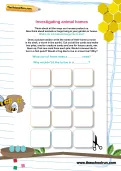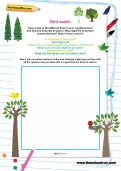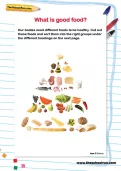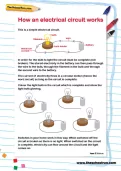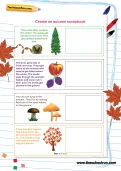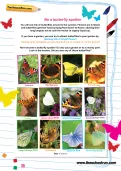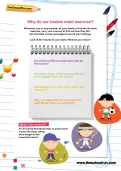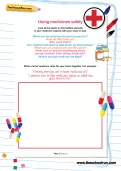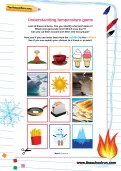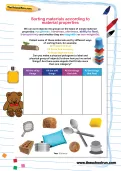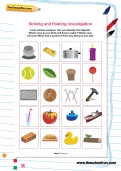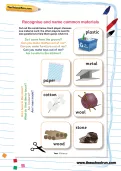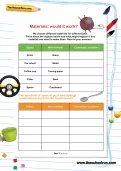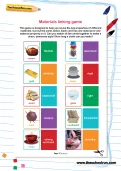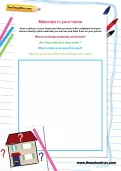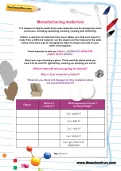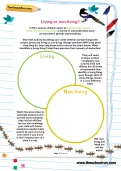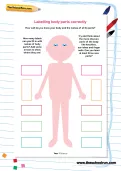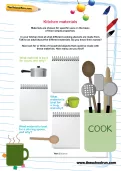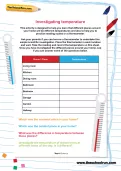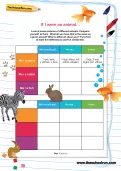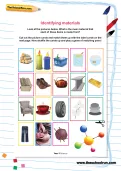Autumn is a great time for collecting! Why not go on an autumn treasure hunt and make a scrapbook with all the things you discover.
or
Register to add to your saved resources
Already a subscriber? to view this content.
You will see lots of butterflies around in the summer. Flowers are in bloom and butterflies get their food by flying from flower to flower, sticking their long tongues out to suck the nectar (a sugary liquid) up. Can you spot any butterflies in your garden or to a nearby park. Look in the bushes. Did you see any of these butterflies?
or
Register to add to your saved resources
Already a subscriber? to view this content.
Whenever you or any member of your family or friends do some exercise, carry out a survey to find out how they felt. Use the table to record your findings. Look at the results of your table. What do you notice?
or
Register to add to your saved resources
Already a subscriber? to view this content.
Some materials are more suitable for particular jobs than others. Look at these pictures and decide which of the materials could be used for each job. Which ones would not be suitable at all?
or
Register to add to your saved resources
Already a subscriber? to view this content.
Look at the labels on the bottles and pills in your medicine cabinet with your mum or dad. Can you answer these questions about them?
or
Register to add to your saved resources
Already a subscriber? to view this content.
Look at these pictures. Can you identify what each item is? Which ones generate heat? Which ones don’t? Can you cut them out and sort them into two groups?
or
Register to add to your saved resources
Already a subscriber? to view this content.
We can sort objects into groups on the basis of simple material properties: roughness, hardness, shininess, ability to float, transparency and whether they are magnetic or non-magnetic. Collect some of these materials and try different ways of sorting them. Can you make a physical pictogram to show how you’ve sorted things?
or
Register to add to your saved resources
Already a subscriber? to view this content.
Look at these pictures. Can you identify the objects? Which ones do you think will float in water? Which ones will sink? Why? Ask a parent if there any that you can test.
or
Register to add to your saved resources
Already a subscriber? to view this content.
Cut out the cards below. Each player chooses one material card; the other players need to ask questions to help them guess what it is.
or
Register to add to your saved resources
Already a subscriber? to view this content.
We choose different materials for different jobs. Think about the objects below and what might happen if this material was used to make them. Record your answers.
or
Register to add to your saved resources
Already a subscriber? to view this content.
This game is designed to help you revise the key properties of different materials. Cut out the cards below. Each card has one material or one material property on it. Can you match all the cards together to make a chain, dominoes-style? How long a chain can you make?
or
Register to add to your saved resources
Already a subscriber? to view this content.
Draw a picture of your house and then go round with a clipboard and identify which materials you can see and label them on your picture.
or
Register to add to your saved resources
Already a subscriber? to view this content.
The shapes of objects made from some materials can be changed by some processes, including squashing, bending, twisting and stretching. Gather a selection of materials from home. Make sure that each object is made from a different material. List the object and the material in the table, then have a go at changing the object’s shape and note on your table what happens.Now have a go at making a glove.
or
Register to add to your saved resources
Already a subscriber? to view this content.
In KS1 science children learn to differentiate between living and non-living things in terms of characteristics such as movement, growth and breathing. Identify which things are living and which are non-living, but watch out ... sometimes it's not as obvious as it seems!
or
Register to add to your saved resources
Already a subscriber? to view this content.
How many labels can you fill in with names of body parts? Add some arrows to show where they are! Try and think about the more obscure parts of the body. Can you learn at least three new parts?
or
Register to add to your saved resources
Already a subscriber? to view this content.
In your kitchen look at what different cooking utensils are made from. Talk to an adult about the different materials. Do you know their names? Now look for or think of household objects that could be made with these materials. How many can you find?
or
Register to add to your saved resources
Already a subscriber? to view this content.
This activity is designed to help you learn that different places around your home will be different temperatures and also to help you to practise reading scales on a thermometer.
or
Register to add to your saved resources
Already a subscriber? to view this content.
Think about all the ways our houses protect us. Now think about animals or bugs living in your garden or house. Where do animals and bugs like to live? Draw a picture and/or write the name of their home. Cut out all the cards and make two piles, one for creature cards and one for house cards; mix them up. Pick one card from each pile. Would a mouse like to live in a fish pond? Would a frog like to live in a bee hive? Why?
or
Register to add to your saved resources
Look at some pictures of different animals. Compare yourself to them. What do you have that is the same as a given animal? What is different about you? Try to find at least five differences and five similarities.
or
Register to add to your saved resources
Already a subscriber? to view this content.
Look at the pictures. What is the main material that each of these items is made from? Cut out the picture cards and match them up with the label cards on the next page. Now shuffle the cards up and play a game of matching pairs!
or
Register to add to your saved resources
Already a subscriber? to view this content.
